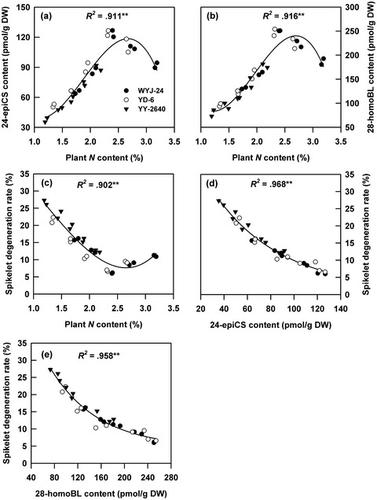当前位置:
X-MOL 学术
›
Food Energy Secur.
›
论文详情
Our official English website, www.x-mol.net, welcomes your
feedback! (Note: you will need to create a separate account there.)
Response of brassinosteroids to nitrogen rates and their regulation on rice spikelet degeneration during meiosis
Food and Energy Security ( IF 4.0 ) Pub Date : 2020-03-04 , DOI: 10.1002/fes3.201 Weiyang Zhang 1, 2 , Lidong Fu 1, 2 , Chuanbao Men 1, 2 , Jixiang Yu 1, 2 , Jiayu Yao 1, 2 , Jiayan Sheng 1, 2 , Yunji Xu 3 , Zhiqin Wang 1, 2 , Lijun Liu 1, 2 , Jianchang Yang 1, 2, 3 , Jianhua Zhang 4
Food and Energy Security ( IF 4.0 ) Pub Date : 2020-03-04 , DOI: 10.1002/fes3.201 Weiyang Zhang 1, 2 , Lidong Fu 1, 2 , Chuanbao Men 1, 2 , Jixiang Yu 1, 2 , Jiayu Yao 1, 2 , Jiayan Sheng 1, 2 , Yunji Xu 3 , Zhiqin Wang 1, 2 , Lijun Liu 1, 2 , Jianchang Yang 1, 2, 3 , Jianhua Zhang 4
Affiliation

|
The plant steroid hormones brassinosteroids (BRs) play pivotal roles in modulating flower and fruit production. Nitrogen (N) is a key factor affecting rice (Oryza sativa L.) production. We hypothesized that BRs would respond to N application rates at spikelet differentiation (SD) and regulate spikelet degeneration in rice. Three rice cultivars were field‐grown and treated with five N rates at SD. Plant N and BRs contents, antioxidant capacity, and energy status were observed during meiosis in young panicles, and their relationships with spikelet degeneration were evaluated. In all the N treatments, the BRs, adenosine triphosphate, and energy charge levels, activities of the enzymes involved in energy metabolism, including cytochrome C oxidase and succinate dehydrogenase, total antioxidant capacity, and grain yield, were the highest, whereas hydrogen peroxide (H2O2) content and vacuolar processing enzymes (VPE) genes expression levels, and spikelet degeneration rate were the lowest when plant N content was 2.6% during meiosis. The rice BRs‐deficient mutants showed substantial reduction in BRs levels, antioxidant capacity, and energy status, but great increase in H2O2 content, VPE genes expression levels, and spikelet degeneration rate than the wild type (WT); moreover, these parameters in WT panicles could be regulated, whereas in BRs‐deficient mutant panicles, they were not distinctly affected by N application. The results indicated that BRs mediate the effects of N rates on spikelet degeneration, and elevated BRs levels in rice panicles effectively inhibit spikelet degeneration when plant N content is 2.6% during meiosis by elevating antioxidant capacity and energy status.
中文翻译:

油菜素甾体对氮素的响应及其对减数分裂过程中水稻小穗变性的调控
植物类固醇激素油菜素类固醇(BRs)在调节花卉和水果的生产中起关键作用。氮(N)是一个关键的影响因素稻(稻L.)生产。我们假设BRs在小穗分化(SD)时对氮的施用量有反应,并调节水稻中的小穗变性。在田间种植了3个水稻品种,并在SD下以5 N的比例处理。在幼穗减数分裂过程中观察到了植物N和BRs的含量,抗氧化能力和能量状态,并评估了它们与小穗变性的关系。在所有N种处理中,BRs,三磷酸腺苷和能量电荷水平,参与能量代谢的酶的活性(包括细胞色素C氧化酶和琥珀酸脱氢酶),总抗氧化能力和谷物产量最高,而过氧化氢( H 2 O 2当减数分裂过程中植株氮含量为2.6%时,液泡蛋白含量,液泡加工酶(VPE)基因表达水平和小穗变性率最低。水稻缺乏BRs的突变体显示BRs水平,抗氧化能力和能量状态显着降低,但H 2 O 2大大增加含量,VPE基因表达水平和小穗变性率均高于野生型(WT);此外,WT穗中的这些参数可以调节,而在BRs缺失的突变穗中,氮的施用对它们没有明显的影响。结果表明,BRs介导了N速率对小穗变性的影响,在减数分裂过程中,当植物N含量为2.6%时,水稻穗穗中BRs含量的升高可通过提高抗氧化能力和能量状态有效抑制小穗变性。
更新日期:2020-03-04
中文翻译:

油菜素甾体对氮素的响应及其对减数分裂过程中水稻小穗变性的调控
植物类固醇激素油菜素类固醇(BRs)在调节花卉和水果的生产中起关键作用。氮(N)是一个关键的影响因素稻(稻L.)生产。我们假设BRs在小穗分化(SD)时对氮的施用量有反应,并调节水稻中的小穗变性。在田间种植了3个水稻品种,并在SD下以5 N的比例处理。在幼穗减数分裂过程中观察到了植物N和BRs的含量,抗氧化能力和能量状态,并评估了它们与小穗变性的关系。在所有N种处理中,BRs,三磷酸腺苷和能量电荷水平,参与能量代谢的酶的活性(包括细胞色素C氧化酶和琥珀酸脱氢酶),总抗氧化能力和谷物产量最高,而过氧化氢( H 2 O 2当减数分裂过程中植株氮含量为2.6%时,液泡蛋白含量,液泡加工酶(VPE)基因表达水平和小穗变性率最低。水稻缺乏BRs的突变体显示BRs水平,抗氧化能力和能量状态显着降低,但H 2 O 2大大增加含量,VPE基因表达水平和小穗变性率均高于野生型(WT);此外,WT穗中的这些参数可以调节,而在BRs缺失的突变穗中,氮的施用对它们没有明显的影响。结果表明,BRs介导了N速率对小穗变性的影响,在减数分裂过程中,当植物N含量为2.6%时,水稻穗穗中BRs含量的升高可通过提高抗氧化能力和能量状态有效抑制小穗变性。











































 京公网安备 11010802027423号
京公网安备 11010802027423号